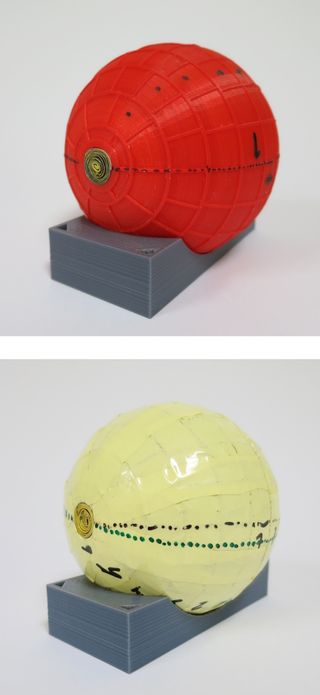
Ripped from the pages of a sci-fi novel, physicists have crafted a wormhole that tunnels a magnetic field through space.
"This device can transmit the magnetic field from one point in space to another point, through a path that is magnetically invisible," said study co-author Jordi Prat-Camps, a doctoral candidate in physics at the Autonomous University of Barcelona in Spain. "From a magnetic point of view, this device acts like a wormhole, as if the magnetic field was transferred through an extra special dimension."
The idea of a wormhole comes from Albert Einstein's theories. In 1935, Einstein and colleague Nathan Rosen realized that the general theory of relativity allowed for the existence of bridges that could link two different points in space-time. Theoretically these Einstein-Rosen bridges, or wormholes, could allow something to tunnel instantly between great distances (though the tunnels in this theory are extremely tiny, so ordinarily wouldn't fit a space traveler). So far, no one has found evidence that space-time wormholes actually exist. [Science Fact or Fiction? The Plausibility of 10 Sci-Fi Concepts]
The new wormhole isn't a space-time wormhole per se, but is instead a realization of a futuristic "invisibility cloak" first proposed in 2007 in the journal Physical Review Letters. This type of wormhole would hide electromagnetic waves from view from the outside. The trouble was, to make the method work for light required materials that are extremely impractical and difficult to work with, Prat said.
Magnetic wormhole
But it turned out the materials to make a magnetic wormhole already exist and are much simpler to come by. In particular, superconductors, which can carry high levels of current, or charged particles, expel magnetic field lines from their interiors, essentially bending or distorting these lines. This essentially allows the magnetic field to do something different from its surrounding 3D environment, which is the first step in concealing the disturbance in a magnetic field.
So the team designed a three-layer object, consisting of two concentric spheres with an interior spiral-cylinder. The interior layer essentially transmitted a magnetic field from one end to the other, while the other two layers acted to conceal the field's existence.
The inner cylinder was made of a ferromagnetic mu-metal. Ferromagnetic materials exhibit the strongest form of magnetism, while mu-metals are highly permeable and are often used for shielding electronic devices.
Get the Space.com Newsletter
Breaking space news, the latest updates on rocket launches, skywatching events and more!
A thin shell made up of a high-temperature superconducting material called yttrium barium copper oxide lined the inner cylinder, bending the magnetic field that traveled through the interior.

The final shell was made of another mu-metal, but composed of 150 pieces cut and placed to perfectly cancel out the bending of the magnetic field by the superconducting shell. The whole device was placed in a liquid-nitrogen bath (high-temperature superconductors require the low temperatures of liquid nitrogen to work).
Normally, magnetic field lines radiate out from a certain location and decay over time, but the presence of the magnetic field should be detectable from points all around it. However, the new magnetic wormhole funnels the magnetic field from one side of the cylinder to another so that it is "invisible" while in transit, seeming to pop out of nowhere on the exit side of the tube, the researchers report today (Aug. 20) in the journal Scientific Reports.
"From a magnetic point of view, you have the magnetic field from the magnet disappearing at one end of the wormhole and appearing again at the other end of the wormhole," Prat told Live Science.
Broader applications
There's no way to know if similar magnetic wormholes lurk in space, but the technology could have applications on Earth, Prat said. For instance, magnetic resonance imaging (MRI) machines use a giant magnet and require people to be in a tightly enclosed central tube for diagnostic imaging.
But if a device could funnel a magnetic field from one spot to the other, it would be possible to take pictures of the body with the strong magnet placed far away, freeing people from the claustrophobic environment of an MRI machine, Prat said.
To do that, the researchers would need to modify the shape of their magnetic wormhole device. A sphere is the simplest shape to model, but a cylindrical outer shell would be the most useful, Prat said.
"If you want to apply this to medical techniques or medical equipment, for sure you will be interested in directing toward any given direction," Prat said. "A spherical shape is not the most practical geometry."
Follow Tia Ghose on Twitter and Google+. Follow Live Science @livescience, Facebook & Google+. Original article on Live Science.
Join our Space Forums to keep talking space on the latest missions, night sky and more! And if you have a news tip, correction or comment, let us know at: community@space.com.

Tia is the assistant managing editor and was previously a senior writer for Live Science, a Space.com sister site. Her work has appeared in Scientific American, Wired.com and other outlets. She holds a master's degree in bioengineering from the University of Washington, a graduate certificate in science writing from UC Santa Cruz and a bachelor's degree in mechanical engineering from the University of Texas at Austin. Tia was part of a team at the Milwaukee Journal Sentinel that published the Empty Cradles series on preterm births, which won multiple awards, including the 2012 Casey Medal for Meritorious Journalism.












